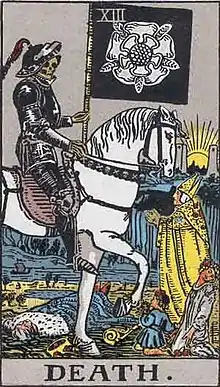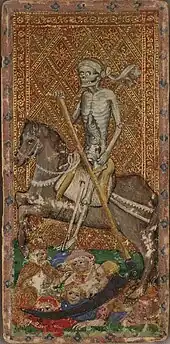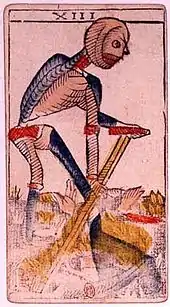
Death (XIII) is the 13th trump or Major Arcana card in most traditional tarot decks. It is used in tarot card games as well as in divination. The card typically depicts the Grim Reaper, and when used for divination is often interpreted as signifying major changes in a person's life.
Description
Some decks, such as the Tarot of Marseilles and the Visconti Sforza Tarot omit the name from the card, calling it "The Card with No Name", often with the implication of a broader meaning than literal death. There are other decks that title Death as "Rebirth" or "Death-Rebirth."
The Death card usually depicts the Grim Reaper, the personification of Death. In some decks, the Grim Reaper is riding a pale horse, and often he is wielding a sickle or scythe. Surrounding the Grim Reaper are dead and dying people from all classes, including kings, bishops and commoners. The Rider–Waite tarot deck depicts the skeleton carrying a black standard emblazoned with The White Rose of York.
In the background are two towers and a rising sun.
Examples
 Charles VI (or Gringonneur) (15th century)
Charles VI (or Gringonneur) (15th century) Cary-Yale Visconti (15th century)
Cary-Yale Visconti (15th century) Pierpont Morgan Bergamo (15th century)
Pierpont Morgan Bergamo (15th century) Jean Dodal Marseilles (1701-1715)
Jean Dodal Marseilles (1701-1715) Rauch Troccas (1831–1838)
Rauch Troccas (1831–1838) Florence Minchiate (1860–1890)
Florence Minchiate (1860–1890) Solesio Piedmontese (1865)
Solesio Piedmontese (1865) Lequart Marseilles (1890)
Lequart Marseilles (1890) Grimaud Etteilla (1890)
Grimaud Etteilla (1890) Papus (1909)
Papus (1909)
Interpretation
According to Eden Gray and other authors on the subject, it is uncommon that this card actually represents a physical death, rather it typically implies an end, possibly of a relationship or interest, and therefore an increased sense of self-awareness.[1][2]
In fact, Gray interprets this card as a change of thinking from an old way into a new way. The horse Death is riding is stepping over a prone king, which symbolizes that not even royalty can stop change.[3]
The card, drawn in reverse, can be interpreted as stagnation and the inability to move or change according to Gray.[4]
According to A. E. Waite's 1910 book The Pictorial Key to the Tarot, the Death card carries several divinatory associations:[5]
13. DEATH.—End, mortality, destruction, corruption; also, for a man, the loss of a benefactor; for a woman, many contrarieties; for a maid, failure of marriage projects. Reversed: Inertia, sleep, lethargy, petrifaction, somnambulism; hope destroyed.
In Astrology, the Death card is associated with the fixed-water sign of Scorpio and its ruling planet, Pluto.[6]
Other versions
See also
References
- ↑ Gray, Eden. The Complete Guide to the Tarot.
- ↑ Bunning, Joan. Learning the Tarot.
- ↑ Gray, Eden. Complete Guide to the Tarot (1970). New York: Crown Publishers.
- ↑ Gray, Eden. The Tarot Revealed (1960). New York: Bell Publishing Company.
- ↑ Waite, Arthur Edward (1979). The Pictorial Key to the Tarot. New York: Samuel Weiser. p. 285. ISBN 0-87728-218-8.
- ↑ "The Death Tarot Card". askAstrology.
Further reading
- A. E. Waite's 1910 Pictorial Key to the Tarot
- Sir James Frazer The Golden Bough
- Hajo Banzhaf, Tarot and the Journey of the Hero (2000)
- Most works by Joseph Campbell
- The Book of Thoth by Aleister Crowley
- G. Ronald Murphy, S.J., The Owl, The Raven, and The Dove: Religious Meaning of the Grimm's Magic Fairy Tales (2000)
- Riane Eisler, The Chalice and the Blade (1987)
- Mary Greer, The Women of the Golden Dawn (1994)
- Merlin Stone, When God Was A Woman (1976)
- Robert Graves, Greek Mythology (1955)
- Joan Bunning, Learning the Tarot
- Juliette Wood, Folklore 109 (1998):15–24, "The Celtic Tarot and the Secret Tradition: A Study in Modern Legend Making" (1998)